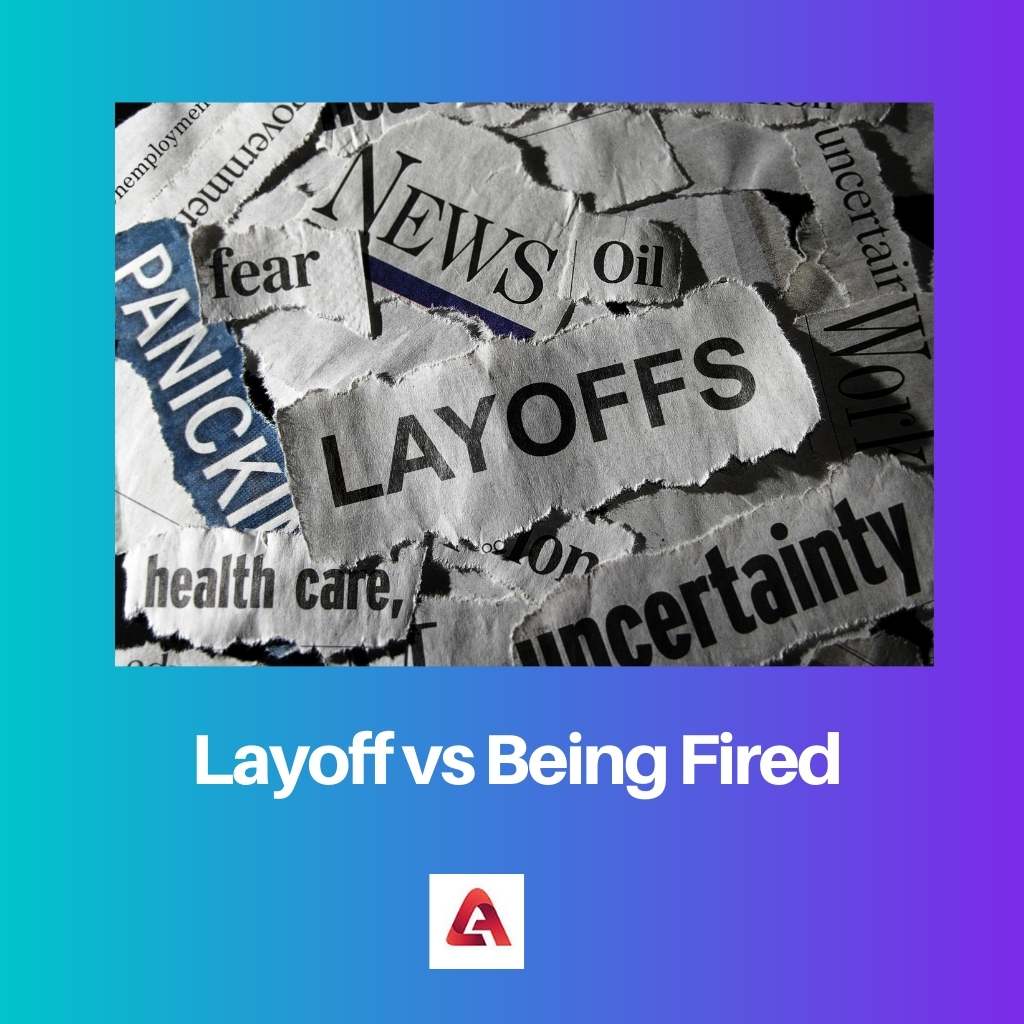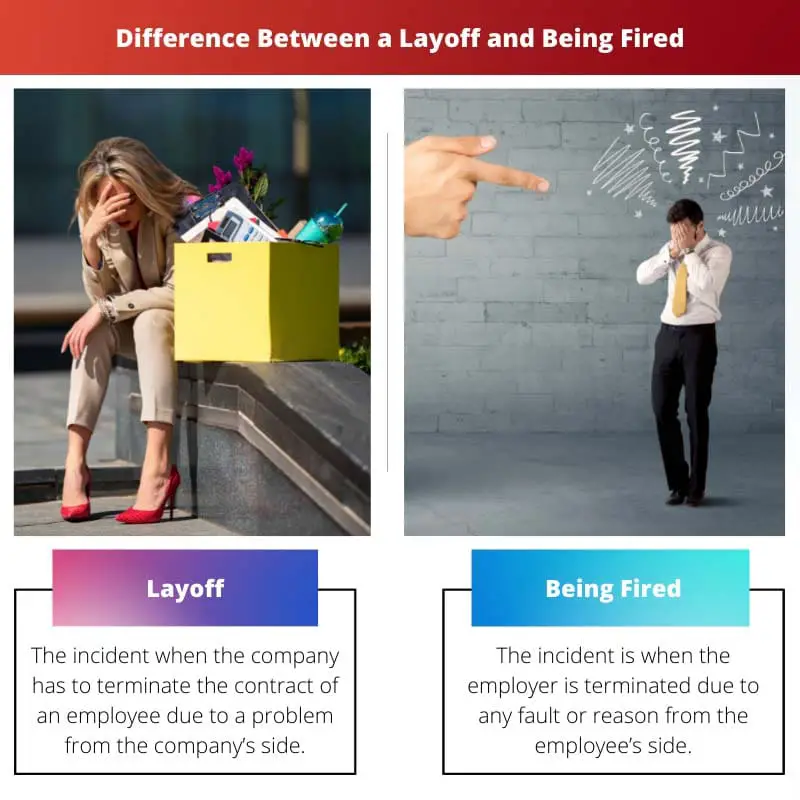Sometimes a person loses their work due to being fired. Another scenario is when a person is laid off from the company. Both lead to the unemployment of the person.
So here are a few differences between layoff and being fired. These differences will help one to understand the difference between them.
Key Takeaways
- Layoffs occur due to business conditions or restructuring, not performance issues.
- Being fired results from poor performance, misconduct, or a breach of company policy.
- Laid-off employees may be eligible for rehire, while fired employees are not.
Layoff vs Being Fired
The difference between layoff and being fired is that in the case of a layoff, the termination is done due to any problem from the company’s side. On the other hand, an employee is being fired if the fault is from the employee’s side. There are some facilities for the employee in case of a layoff, but there are no facilities for the employee who is fired from his duty.

A layoff is an incident when the company has to terminate an employee’s contract due to a problem from the company’s side. In this case, the company may face financial or legal issues.
The company is always forced to lay off employees. Otherwise, this is not a good option even for the company.
Being fired is an incident when the employer is terminated due to any fault or reason from the employee’s side. This proves to be a very bad mark on the career of the person.
This is very disrespectful as well as they will have a very tough situation finding another job. This is mostly done at the last stage of issues.
Comparison Table
| Parameters of comparison | Layoff | Being Fired |
|---|---|---|
| Definition | The incident when the company has to terminate the contract of an employee due to a problem from the company’s side. | The incident is when the employer is terminated due to any fault or reason from the employee’s side. |
| Fault | The backlog is from the companies side | The backlog is from the employee side |
| Cause | The maybe any relocation for the company or over staff problems etc | The cause may be due to dishonesty, or negative remarks on performance etc. |
| Pay | The employee gets the severance pay from the company | The employee does not get any severance pay. |
| Unemployment Benefits | In this case, the employee is applicable for unemployment benefits from the company. | In this case, the person is not eligible for unemployment benefits from the company. |
What is a Layoff?
The layoff is a condition when a company is bound to cancel the contract of its employees. This happens due to many reasons for the company side.
There are many hard times for a company during which they have to deteriorate the number of employees. The layoff case is not due to any employee. It’s completely considered the company’s fault.
This may happen due to the company being running is a loss for a long time, or maybe due to relocation of the company, or may also happen due to over recruitment of staff.
All these factors are personally the company’s issues, but they are forced to cancel their staff contracts. In this condition company always provides some benefits to the laid-off employees.
The benefit depends on the company, but some benefits, like severance pay, are very common. Normally every company provides these to the employees.
The employees may also ask for unemployment benefits from the company as they have a family to feed. This scenario is also very harmful to the reputation of the company.
The people will lose faith in the company, and the number of people applying to work with the company will reduce. This situation happens in the very rare case when the company is not able to bear the number of staff they are having.
What is Being Fired?
Being fired is a condition when an employee of a company is terminated due to some cause. The cause is mostly from the employee’s side. This may be any complaint against the person, or It may be any other reason.
An employee is mostly fired by the head of the company against proper documents.
This is not done on a notice basis. If the employee receives the letter, he is off from duty the next day. So an employee is always wanted to be respectful, trustful, and trustworthy.
So if they violate the norms at a very high level, a company is forced to fire their employee.
In case of a being fired, the employee does not get any severance pay from the company. Severance pay is an amount that is given to the employee as compensation to the employee.
The compensation is on an enthusiastic basis that a person lost his job. He also has a family to feed, so compensation is given.
But if a person is fired, there is no place for enthusiasm as the faults are mostly done in the conscious mind. If not done consciously, then the person would not have been fired. So there is no facility for severance pay in this case.

Main Differences Between a Layoff and Being Fired
- The incident when the company has to terminate the contract of an employee due to a problem from the company’s side is called a layoff, but in contrast to that, the incident when the employer is terminated due to any fault or reason from the employer side is called being fired.
- In the case of a layoff, the backlog is from the company’s side, but in comparison to that, in the case of being fired, the backlog is from the employee side.
- The layoff may be due to any relocation for the company or overstaffing problems etc. on the other hand, the cause of being fired may be due to dishonesty, negative remarks on performance, etc.
- The employee gets severance pay from the company if they are laid off, but in contrast, the employee does not get any severance pay if they are fired.
- In the case of a layoff, the employee is applicable for unemployment benefits from the company, but in contrast to that, in this case of being fired, the person is not eligible for unemployment benefits from the company.

- https://onlinelibrary.wiley.com/doi/abs/10.1002/job.4030150705
- https://journals.sagepub.com/doi/abs/10.1177/1747954116636706

The article eloquently addresses the delicate topic of layoffs and terminations, offering an in-depth analysis of the underlying causes and implications for employees and organizations. The philosophical undertones resonate with the complexities of the modern labor landscape.
This article provides a clear and concise comparison of the differences between being laid off and being fired. The comparison table is especially useful for people who are not familiar with the topic.
This article highlights the critical aspects of being laid off and being fired in the workplace. The information is essential for both employees and employers to understand their rights and responsibilities.
It’s unfortunate that employees who are fired do not receive any severance pay, but this article clearly explains the reasons behind this practice. The comparisons made are insightful and valuable for individuals in the workforce.
The article effectively clarifies the consequences of being laid off versus being fired, shedding light on the stark contrast between the two. The references provide scholarly support for the content.
The descriptions and examples given in the article make it easy to understand the distinction between being laid off and being fired. I appreciate the informative nature of the content.